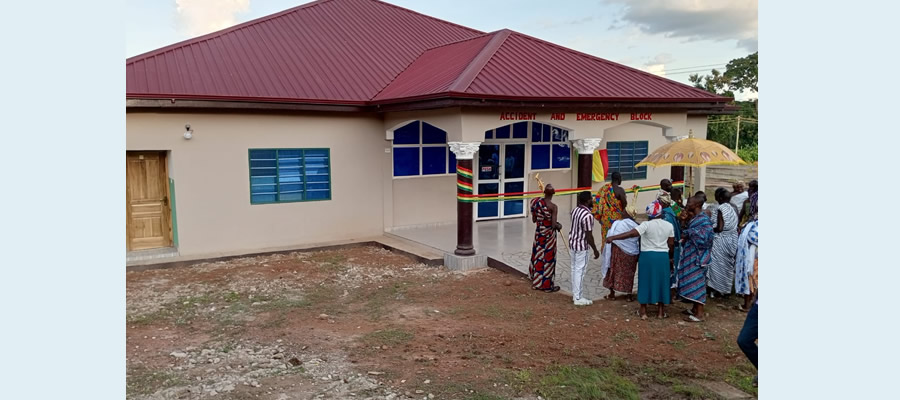

DISABILITY
Introduction
Improving the conditions of PWDs will contribute to aspects of the overall development of the nation’s human resources. With appropriate and well-designed policies, PWDs can live a meaningful and dignified life in society while contributing positively to its development. Disabilities are now considered a social development issue because of its direct association with poverty. The development of a nation depends on the contribution of not only a segment of the population but also on the collective contribution of every individual including PWDs. In an attempt to understand the situation of PWDs as a guide for policy formulation, the Ghana Statistical Service, for the first time, collected specific data on PWDs in the 2010 Population and Housing Census.
Persons with disability (PWD) have been defined as those who are unable to or are restricted in the performance of specific tasks/activities due to loss of function of some part of the body as a result of impairment or malformation (Ghana Statistical Service, 2013). As a result, PWDs are mostly regarded as less productive and not capable of contributing to socio economic development. Accordingly, they are often seen as a burden on society in general and their families in particular. Their unfortunate circumstances are viewed by others as a curse or punishment. As a result PWDs face a wide range of life challenges because, disability, in whatever form or type, can reduce an individual’s ability to function to his/her full potential. Disability can limit an individual’s full participation in a number of activities in life. Furthermore, they tend to have poorer health status, lower educational attainment, less economic participation and higher level of poverty than without disabilities (World Health Organization, 2011). This chapter presents data collected on PWDs and discusses their economic activity status, educational attainment and literacy in the Dormaa West District.
Population with Disability
Table 6.1 presents information on people with disability in the District. The number of persons with disability (PWDs) is 866 constituting 1.8 percent of the population. Male and female disabled account for 2.0 percent and 1.6 percent of their respective populations respectively. PWDs account for 2.2 percent of the urban population and 1.7 percent of the rural population.
Type of Disability
Types of disabilities recorded in the census include sight, hearing, and speech, physical, intellectual and emotional. Disability cases can be multiple, that is, one person can have more than one type of disability. According to the Ghana Statistical Service National Report on Disability (2012), nationally about two out of every five of the population with disability (38.3%) have more than one type of disability condition. About the same proportion of males (38.2%) and females (38.6) have multiple disabilities.
In the Dormaa West District, Table 6.1 shows that the 866 people with disability reported 1,296 disabilities yielding an average of 1.50 disability cases per person. Out of the total 866 disabled people, 37.1 percent have sight impairment which is the commonest form of disability. The next commonest disability is physical disability (27.7%), followed by emotional problems (21.4%), speech disability (19.2%) and intellectual disability (16.4%).
Among the 498 male PWDs, the commonest disability was sight impairment reported by 34.7 percent of these people. The next commonest disability among males was physical impairment which was reported by 26.7 percent of these people. Slightly over one in five (23.2%) have speech problems and another one in five (20.5%) have emotional problems. Intellectual disability reported by 0.3 percent is the least common disability among males. Among the 368 females with disability sight impairment is the commonest. This is followed in order of importance by physical disability (29.1%), emotional disability (22.6%) and hearing disability (19.0%).
Distribution of Disability by Locality of Residence
Sight impairment is the commonest disability in both urban and rural areas. In the urban areas, there are 237 PWDs representing 2.2 percent of the total urban population of 10,587. About forty-six percent (46.4%) of PWDs report sight as their disability. The other common disabilities reported by urban PWDs are physical disability (23.6%), emotional problems (19.0%) and speech (19.0%). The three most common disabilities reported by males in urban areas are sight (41.4%), physical (27.9%) and emotional disorders (18.0%). Females in urban areas also reported sight as the most common (50.8%) followed by physical (19.8%) and emotional problems (19.8%). Intellectual disability is ranked as the least reported form of disability for both male (0.3%) and female (0.2%) in the urban areas.
In the rural areas of the District, 629 or 1.7 percent of the rural population reported being PWDs. The proportions of disabilities in the rural areas follow the trend observed in the urban areas. Sight (33.5%) was the commonest followed by physical (29.3%), speech (22.4%) and emotional disorders (22.3%). The least reported form of disability in the rural communities is intellectual (18.4%). For the male and female distribution of PWDs in the rural areas, sight recorded the highest (32.8%) among males and females (34.7%). Intellectual disability again is ranked as the least reported form of disability for both male (0.4%) and female (0.3%) in the rural areas.
Disability and Economic Activity Status
Table 6.2 shows the distribution of PWDs by economic activity status and sex. In the District, out of 28,488, persons aged 15 years and older, 690 or 2.4 percent are PWDs, of which about 64.6 percent are employed, 1.3 percent are unemployed and 34.1 percent are economically not active. The proportion of PWDs who are economically not active is 16 percent higher than the proportion of the not disabled population who are economically not active (18.1%). This difference suggests that disabilities are a significant form of impairment affecting employment. Physical impairment is the most important disability influencing the economically not active status with 50.0 percent of physically-disabled people being economically not active. The other important disabilities affecting the economically not active status of people are speech and sight.
Disability and Education
Table 6.3 confirms the lower educational achievement of persons with disability. Whereas only 29.0 percent of those with no disability have never attended school, 46.1 percent of those with disability have never attended school. The disadvantaged situation of the disabled is reflected at the various levels of education. About nine percent (8.6%) of those with no disability are attending pre-school level (Nursery and Kindergarten) compared to 2.4 percent of those with disability. The situation is somehow better at the basic level (primary, JSS/JHS, middle), 53.9 percent for those with no disability and 45.0 percent among the disabled attend basic schools. At the secondary level, the disabled have a proportion of 4.3 percent compared to the 6.1 percent among those without disability. The proportions of people who have completed education beyond secondary school level is generally low in the District and this applies to both able-bodied people and disabled persons. Only 2.4 percent of people without disabilities have completed education beyond secondary school level compared to the corresponding proportion of 2.2 percent for PWDS, an insignificant difference between the two groups.
In relation to the different disability types, there is some association between the type of disability and education level. For example, 46.1 percent of those with disability have never attended school, but the proportions for those with physical (52.8%), hearing (59.5%) and intellectual disability (51.8%) are higher. Furthermore, for the primary level, the proportion for intellectual disability (25.2%) and physical disability (21.5%) is higher than the total proportion with disability (20.7%). The proportion of the disabled who have attended secondary level is 4.3 percent. The proportions for all the types of disabilities fall within a narrow range of 3.6 percent (intellectual disabilities) to 4.7 percent (emotional disorder) except “other” disabilities (1.3%).
In summary, information from Table 6.3 generally indicates that the level of education is lower among persons with disability with the access to education also varying by the type of disability. The absence of special schools in the District affects the enrollment and retention of PWDs especially at the pre-school and basic levels.
Date Created : 11/23/2017 5:35:49 AM












 facebook
facebook
 twitter
twitter
 Youtube
Youtube
 +233 593 831 280
+233 593 831 280 0800 430 430
0800 430 430 GPS: GE-231-4383
GPS: GE-231-4383 info@ghanadistricts.com
info@ghanadistricts.com Box GP1044, Accra, Ghana
Box GP1044, Accra, Ghana